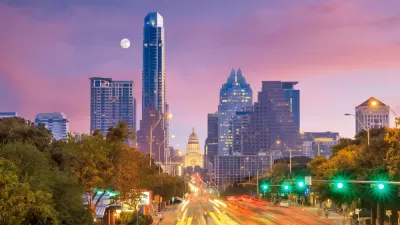Having sat through a Transportation Task Force committee meeting recently where a representative of local government requested funds to enable the completion of a particular road project, I had to chuckle – folks had been asking for the final funds for that road for several years and, several times, various community leaders had touted the resolution of the funding problem with “full speed ahead” declarations. While not quite as embarrassing as the President Bush’s now dated declaration of “Mission Accomplished” in Iraq, it was gaining the same notoriety locally. The actual construction was less than half completed and years away from being finished. Several levels of government ha
Having sat through a Transportation Task Force committee meeting recently where a representative of local government requested funds to enable the completion of a particular road project, I had to chuckle – folks had been asking for the final funds for that road for several years and, several times, various community leaders had touted the resolution of the funding problem with "full speed ahead" declarations. While not quite as embarrassing as the President Bush's now dated declaration of "Mission Accomplished" in Iraq, it was gaining the same notoriety locally. The actual construction was less than half completed and years away from being finished. Several levels of government had consternated over the project. Neighbors had banded together numerous times pleading for help, asking for the uncertainty to be resolved, voicing their distrust of the leadership, and noting the painful impacts of construction on their lives. Rebuilding the few miles of urban arterial in a county of well over a million folks had taken on a life of its own, and its funding decisions, say nothing of construction, had extended well beyond the term limits of some of the folks who thought they had solved the problems a few times already.
Sometimes laughing is a reaction not to humor but to frustration. The progress on many of our transportation problems reminds me of watching video clips of mud bogging where there is a lot of wheel spinning but not much forward progress as the truck or all-terrain vehicle gets bogged down in the mud then sinks deeper until the driver signals for help. We may be nearing that too-deep hole with our transportation system. We are already spinning our wheels a lot and there is a big hole ahead. Our tires may not be big enough; we may need a tow to solid ground.
Many of the projects that might be important in meeting transportation needs seem like big mud holes – expensive, contentious, impactful, and requiring a plethora of approvals among diverse oversight entities. Our history of good intentions in being holistic in planning transportation has resulted in creating an administrative and decision making obstacle course that challenges the most adept and tries everyone's patience. This is exacerbated by a dearth of funding. In a way, transportation planners should be glad there is a resource constraint; if not, then the onerous planning/decision making process would be the critical path element and its flaws more fully exposed to the public's wrath.
In the past few decades federal transportation legislation has created and funded a New Starts program to build rail transit systems. It has garnered a great deal of attention and is an aggressively-sought source of funding for new light rail projects. In 1990, the U.S. had 692 track miles of light rail, and in 2002 the number, according to the National Transit Database, was 1114 miles, indicating construction of 422 miles of light rail track in that dozen years. By contrast, the first Department of Commerce and Labor census of the street railway industry in 1890 noted 1262 track-miles of electrically operated trolley. A count in 1902 indicated 22,000 track-miles electrically operated – an increase of more than 20,000 track miles in 12 years.[1] Another source noted, "By the end of 1903, America's 30,000 miles of street railway were 98 percent electrified."[2] The source went on to say, "The public transportation system of the United States, easily the best in the world in 1900..." Census counts indicate the U.S. population numbered fewer than 80 million in 1900, slightly over one quarter of today's number with a far lower share concentrated in urban areas.
Certainly, street trolleys are not the same as LRT systems and I don't mean to suggest that we should be building what would comparatively be several thousand of miles of guideway per year. It does suggest that the Americans around the end of the 19th century moved quickly to make changes to address mobility problems and leverage new technologies of the time. Perhaps there are some lessons to be learned. Were there elements of process, decision making, funding strategies, or responsiveness to the market that offer lessons for today? Was the infrastructure investment of the time scaled to the available resources more closely than the grand schemes of today?
Times aren't the same, and old solutions or methods are not necessarily right for today, but today's solutions and processes might not be right for tomorrow either. While much is right about the transportation systems of today, the public and many in the profession will readily concede that we seem to be bogged down in the mud. As we struggle to build a few miles of roadway or guideway – by no measure keeping pace with growing demand say nothing of catching up or building for the future – we seem to be spinning our wheels more than in the past. The public would be nearly unanimous in arguing that we need to get more transportation for our transportation dollar, and the profession would be near unanimous in believing that we need more dollars to have any realistic expectation of making progress. Both statements are true, but are we deep enough in the mud to build a consensus or are we going to spin our wheels, digging in deeper first before someone or something comes to the rescue?
[1] "The Time of the Trolley: The Street Railway from Horsecar to Light Rail," William D. Middleton, Golden West Books, 1987

Planetizen Federal Action Tracker
A weekly monitor of how Trump’s orders and actions are impacting planners and planning in America.

Map: Where Senate Republicans Want to Sell Your Public Lands
For public land advocates, the Senate Republicans’ proposal to sell millions of acres of public land in the West is “the biggest fight of their careers.”

Restaurant Patios Were a Pandemic Win — Why Were They so Hard to Keep?
Social distancing requirements and changes in travel patterns prompted cities to pilot new uses for street and sidewalk space. Then it got complicated.

Platform Pilsner: Vancouver Transit Agency Releases... a Beer?
TransLink will receive a portion of every sale of the four-pack.

Toronto Weighs Cheaper Transit, Parking Hikes for Major Events
Special event rates would take effect during large festivals, sports games and concerts to ‘discourage driving, manage congestion and free up space for transit.”

Berlin to Consider Car-Free Zone Larger Than Manhattan
The area bound by the 22-mile Ringbahn would still allow 12 uses of a private automobile per year per person, and several other exemptions.
Urban Design for Planners 1: Software Tools
This six-course series explores essential urban design concepts using open source software and equips planners with the tools they need to participate fully in the urban design process.
Planning for Universal Design
Learn the tools for implementing Universal Design in planning regulations.
Heyer Gruel & Associates PA
JM Goldson LLC
Custer County Colorado
City of Camden Redevelopment Agency
City of Astoria
Transportation Research & Education Center (TREC) at Portland State University
Camden Redevelopment Agency
City of Claremont
Municipality of Princeton (NJ)






























